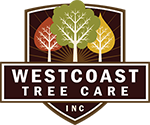Trees play a crucial role in our environment, offering shade, beauty, and a habitat for wildlife. Proper tree care is essential for maintaining the health and beauty of these natural assets. However, misconceptions can lead to unintentional harm rather than benefits. That’s why the certified arborist at Westcoast Tree Care would like to debunk some of the most common tree care myths and shed some light on the best practices that promote tree health.
Myth 1: Topping is a Safe Way to Reduce Tree Size
The Truth: Topping, the practice of removing the top portion of a tree is incredibly harmful. It can lead to severe stress, making trees more susceptible to disease and decay. Topping also disrupts a tree’s natural structure and growth patterns, resulting in weak, unsightly regrowth. Instead of topping, proper pruning techniques should be employed to manage tree size and maintain health.
Myth 2: Wound Dressings Help Trees Heal
The Truth: Applying wound dressings (such as paint or tar) to pruning cuts or other injuries was once thought to accelerate healing and prevent disease. However, research shows that most trees are better off without these treatments. Trees have their own ability to seal wounds and compartmentalize decay. Wound dressings, on the other hand, can trap moisture and decay, hindering the natural healing process.
Myth 3: Trees Can Be Planted Anywhere
The Truth: Not all trees thrive in all locations. Factors like soil type, pH, sunlight, and space constraints significantly influence a tree’s health and growth. Planting a tree in an unsuitable place can lead to stunted growth, increased susceptibility to pests and diseases, and eventual decline. That’s why it’s essential to select the right tree for the right place while considering its mature size, environmental needs, and the landscape’s limitations.
Myth 4: Pruning Can Be Done Any Time of the Year
The Truth: While some pruning can be done year-round, the best time for major pruning depends on the tree species and the desired outcome. For many trees, dormant season pruning (late fall to early spring) is ideal as it minimizes stress and reduces the risk of pest and disease infestation. However, flowering trees and certain shrubs may benefit from post-bloom pruning. That’s why it’s important to understand the specific needs of each tree to determine the optimal pruning schedule.
Myth 5: A Healthy Tree Will Never Fall
The Truth: Even healthy trees can fall under certain conditions. Severe weather events, such as high winds, heavy snow, or ice accumulation, can cause tree failure. Additionally, hidden issues like internal decay or root damage can cause a tree to fall unexpectedly. Regular inspections by a certified arborist can help identify potential risks and take preventive measures to protect your property and loved ones.
Myth 6: All Trees Benefit from Mulch
The Truth: While mulch can offer many benefits to trees (such as moisture retention, temperature regulation, and weed suppression), improper mulching can be harmful. “Volcano mulching,” where mulch is piled high against a tree’s trunk, can lead to moisture buildup, decay, and pest infestations. The correct way to mulch is to create a donut-shaped ring around the base of the tree, keeping the mulch away from the trunk.
Myth 7: Removing Lower Branches Increases Tree Health
The Truth: Lower branches play a vital role in a tree’s development and overall health. They help stabilize the tree and facilitate nutrient flow. Randomly removing lower branches, a practice known as “lion-tailing,” can lead to a weakened structure and increased vulnerability to wind damage. Pruning should always be done with a clear understanding of tree biology and structural integrity.
Bellingham Tree Care
Tree care is a complex field with practices and recommendations based on ongoing research and field observations. At Westcoast Tree Care, we’re committed to using the most current, science-based methods to care for your trees. By debunking these common myths, we aim to foster a greater understanding of proper tree care practices, ensuring the health and beauty of your trees for years. If you would like more information about any of our tree care services in Bellingham, Washington, contact us by filling out our online form or call 1.800.767.8733 for a no-cost, no-obligation quote.








